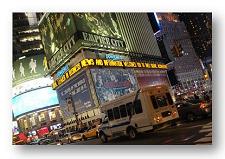 There was a lot of collective attention these past few days to New York City. And that got me thinking that when you’re vacationing in the city or doing business there, you often find yourself on Times Square among all the neon, billboards, and human distractions. And where do your eyes gravitate? To the news ticker, of course. It’s riveting, amidst all the glitz, the lights, and the crowds. It connects you with the reality of the moment.
There was a lot of collective attention these past few days to New York City. And that got me thinking that when you’re vacationing in the city or doing business there, you often find yourself on Times Square among all the neon, billboards, and human distractions. And where do your eyes gravitate? To the news ticker, of course. It’s riveting, amidst all the glitz, the lights, and the crowds. It connects you with the reality of the moment.
And I’ll bet that when many of you first broke into radio, pulling down a weekend or overnight shift, one of the fascinations was staring at the wire machine. In a real-time way, there was everything happening in the world, in your state, or your town all flowing out of that one gadget.
Today, its equivalent may be Twitter. I get this feeling when I have TweetDeck fired up on my laptop or iPhone. The tweets have a sort of teletype effect because there’s always something new, interesting, or even weird coming from my pre-programmed silos.
It’s not surprising that news organizations are beginning to get that same feeling. The Boston Globe recently installed a “tree” of monitors that displays relevant tweets throughout the day – right in the center of the newsroom.
It’s called the “Information Radiator,” and according to the Nieman Journalism Lab, it has several goals:
- Increase the dissemination of information
- Amp up familiarity with new digital information sources
- Encourage Globe journalists to become active on Twitter
I would add a fourth goal – to put these staffers in closer touch with the audience they serve. Like “The Backchannel” at WXYZ-TV in Detroit, it becomes impossible to ignore the fact there are people out there, reacting to the news, and at times, creating content by sending links, videos, and their own thoughts and ideas.
 But what about the expense? The Nieman folks estimate that for about two grand – six monitors, three PCs, Velcro, and a pole.
But what about the expense? The Nieman folks estimate that for about two grand – six monitors, three PCs, Velcro, and a pole.
It’s a small price to pay for immediacy, relevance, and better engagement with customers who are buying the paper or at least visiting it online.
Why isn’t there one of these in every radio station in America? Monitors could include the station’s (or the DJ’s) Twitter feed, the Facebook page, and ongoing texts.
Sometimes the friendly confines of the air studio can be isolating. And while having a cable news channel on a monitor may make a DJ or talk host feel like she’s in touch, there is nothing more electric than watching social media channels at work. And perhaps it’s true that real “news” may be coming from sources like Twitter than the Associated Press.
And the more you work social media outlets, the more they reward you with feedback, reaction, and ultimately the engagement that affords media brands a unique opportunity to connect with an audience that we almost never saw pre-Internet.
Newspapers have made a lot of mistakes during these past ten years. Radio would be wise to learn from them, especially the ideas that just might help our medium make the digital transition a bit more smoothly.
Change is hard. Tools like this help make it easier.
- What To Do If Your Radio Station Goes Through A Midlife Crisis - April 25, 2025
- A 2020 Lesson?It Could All Be Gone In A Flash - April 24, 2025
- How AI Can Give Radio Personalities More…PERSONALITY - April 23, 2025




Leave a Reply